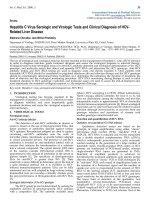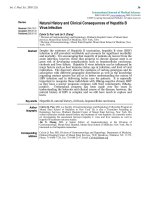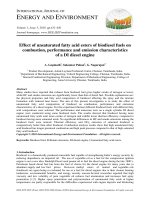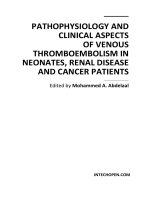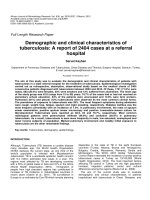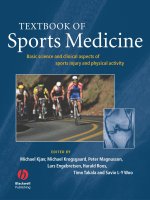Demographic and clinical characteristics of tuberculosis: A report of 2404 cases at a referral hospital pot
Bạn đang xem bản rút gọn của tài liệu. Xem và tải ngay bản đầy đủ của tài liệu tại đây (61.71 KB, 5 trang )
African Journal of Microbiology Research Vol. 6(9), pp. 2033-2037, 9 March, 2012
Available online at
DOI: 10.5897/AJMR11.1250
ISSN 1996-0808 ©2012 Academic Journals
Full Length Research Paper
Demographic and clinical characteristics of
tuberculosis: A report of 2404 cases at a referral
hospital
Servet Kayhan
Department of Pulmonary Diseases and Tuberculosis, Chest Disease and Thoracic Surgery Hospital, Samsun, Turkey.
E-mail:
Accepted 14 December, 2011
The aim of this study was to evaluate the demographic and clinical characteristics of patients with
tuberculosis in a state referral hospital for the treatment of tuberculosis. Epidemiological investigation
carried out as retrospective, descriptive, observational study based on the medical charts of 2404
consecutive patients diagnosed with tuberculosis between 2003 and 2010. Of these, 1721 (71.6%) were
males, 683 (28.4%) were females, 35% were smokers and 12% suffered from alcoholism. The mean age
of the study group was 42.6 (range from 15 to 89) years. 74.7% of the cases had or had not received an
elementary school education. 64% of the patients were unoccupied and 12.8% were farm workers.
Pulmonary (81%) and pleural (12%) tuberculosis were observed as the most common clinical forms.
The prevalence of exposure to tuberculosis was 26%. The most frequent symptoms during admission
were cough, weight loss, fatigue, sputum and night sweating, respectively. Diabetes mellitus was the
most frequent comorbidity with an incidence of 7.9%. In pulmonary involvement, the rates of sputum
smear examination, positive sputum smear microscopy and positive Lowenstein-Jensen culture for
Mycobacterium Tuberculosis were reported as 82.9, 62 and 70.7%, respectively. Most common
radiological patterns were parenchymal infiltrate (48.8%) and cavitation (28.9%) in pulmonary
tuberculosis. As a result, tuberculosis is seen more frequently in male, low educated, unemployed and
lower income subjects of population. Marked pulmonary involvement and notably initial exposure to
tuberculosis are the other remarkable findings.
Key words: Tuberculosis, demography, epidemiology.
INTRODUCTION
Although, Tuberculosis (TB) became a curable disease
many decades ago, the World Health Organisation
(WHO) declares the current state, as one third of the
world’s population is infected with Mycobacterium
tuberculosis. TB is a worldwide epidemic health concern
with 9.4 million estimated new cases in a year. The
regions most affected by TB are developing countries
with a 55% of global cases in Asia and 31% in the Africa
(World Health Organisation, 2010). Immigration of
people from high prevalent regions has contributed to
increase of TB incidence in industrialised countries in
recent years (Odone et al., 2011). TB surveillance in
Europe is co-ordinated by EuroTB which reveals alarming
disparities in the rates of TB in the eight European
countries (Turkey, Albania, Bosnia and Herzegovina,
Bulgaria, Croatia, Macedonia, Romania, Serbia and
Montenegro). The WHO, 2010 Global Tuberculosis
Control Report estimated the incidence of smear-positive
tuberculosis cases in Turkey as 13/100,000 (World
Health Organisation, 2010). The most important factors
affecting TB control in Turkey are the high population
increase, migration patterns, social and cultural
differences among the regions (Bozkurt et al., 2009).
The aim of the current study was to evaluate
demographic and clinical characteristics of patients
hospitalized with tuberculosis in Chest Diseases and
2034 Afr. J. Microbiol. Res.
Thoracic Surgery Hospital, located in city of Samsun in
central part of Turkey’s Blacksea region.
MATERIALS AND METHODS
This was an epidemiological investigation carried out as an
observational, retrospective, descriptive study of adult patients with
tuberculosis diagnosed and hospitalized between 2003 and 2010,
based on the collection of data from the medical records of the
patients. The study was approved by the educational and research
committee and conducted in accordance with the guidelines of the
declaration of Helsinki.
The following variables were subjected to descriptive analyses:
age, gender, marital status, level of education, occupation, monthly
income, employment status and health insurance status at the time
of admission. In addition, we reviewed TB disease characteristics
for each case such as clinical, radiological and microbiological
features, diagnostic criteria, TB type ("new case”, where a first time
TB diagnosis is made and reported, or “re-treated cases”), site of
disease (pulmonary, extra pulmonary or disseminated) and risk
factors for TB; both behavioral risk factors, contact history;
alcoholism; smoking; number of households and clinical risk factors
such as presence of co-morbidities.
A fluorometric BACTEC technique (BACTEC MGIT 960 system;
Becton–Dickinson Diagnostic Instrument Systems) was used for
routine testing of susceptibility to first line anti-TB drugs, including
isoniazid, rifampin, ethambutol, and streptomycin. The incidence of
drug-induced hepatotoxicity in the study group was noted. Patients
were followed up either in the hospital or in the TB dispensary for
treatment outcome.
RESULTS
The total number of consecutive hospitalized patients
with tuberculosis diagnosed during the study period was
2404. The analysis of the epidemiological data showed
that, 683 (28.4%) of the cases were females and 1721
(71.6%) were males. The mean age for the study group
was 42.6 (range 15 to 89) years. Regarding marital
status, 731 (30.4%) patients were single, separated or
widowed. With regard to the level of education, 520
(21.6%) had an incomplete elementary school education
or were illiterate, 1277 (53.1%) had received an
elementary school education, 327 (13.6%) completed
secondary schooling, 324 (13.5%) had a high school
certificate and 119 (4.95%) were graduated from
university. 35% were smokers and 12% suffered from
alcoholism. 68.7% of the patients reported less than $300
monthly income. The most common occupation was farm
worker (12.8% of the patients), and 63.5% of the patients
were unoccupied, classified as house wife, unemployed
or irregular employer. Almost all of the patients (87.1%)
had health insurance of some type. Number of
households was 1 to 2 in 332 (13.8%) patients; 3 to 4 in
641 (26.7%) patients; 5 to 6 in 764 (31.8%) patients and
above 7 in 767 (31.9%) patients.
Predisposing factors for TB were identified in 411
(19.17%) patients (Table 1). Diabetes mellitus was the
most frequent co-morbidity with an incidence of 7.9%.
Other risk factors identified were chronic obstructive
pulmonary disease, anemia, chronic renal failure, lung
cancer, epilepsy, mental retardation, schizophrenia, drug
addiction, bronchiectasis, pregnancy, Down’s syndrome,
human immunodeficiency virus (HIV) infection, and
silicosis. Intrathoracic and extrathoracic tuberculous
lymphadenitis were identified in 46 (1.91%) of the
patients. The prevalence of tuberculosis exposure was
25.8% (19.7% within the household, 6.1% outside home).
The most common clinical form of the disease was the
isolated pulmonary form in 1940 (80.7%) patients. Pleural
TB was accompanying pulmonary TB in 84 (3.5%)
patients. Common extra pulmonary sites included the
pleura and the peripheral lymph nodes, which were
affected in 12.2 and 1.9% of all tuberculosis cases
reported, respectively. Less frequent incidents were the
gastrointestinal tract in 10 (0.4%), genitourinary tract in 8
(0.33%), pericardium in 7 (0.29%), disseminated
tuberculosis (miliary) in 6 (0.25%), vertebral in 5 (0.2%),
larynx in 2 (0.08%), and chest wall, pancreas, tongue,
palatine tonsil in 1 (0.04%) patient each (Table 2). A total
of 2113 (87.9%) were classified as “new cases”, 262
(10.9%) as “recurrence cases”, either failure or relapses,
and 1.2% of patients admitted after irregular treatment.
The most common symptoms during admission in
pulmonary TB were cough, weight loss, fatigue,
expectorate and night sweating, respectively (Table 3).
The most common radiological patterns observed in the
chest X-rays of 2022 pulmonary and pleural TB were lung
field infiltrates in 986 (48.76%) followed by cavitation in
586 (28.98%), pleurisy in 234 (11.57%), and nodularity
154 (7.61%), respectively. In pulmonary tuberculosis,
sputum examination was performed in 82.9% of the
patients and reported positively in direct microscopic
examination as 62%. Löwenstein- Jensen culture was
used as the gold standard and positive in 70.7% of the
study group. The diagnostic method of TB was detection
of Mycobacterium tuberculosis in the sputum on 1353
(56.3%) of patients, diagnosis by means of clinical and
radiological findings on 346 (14.4%) of patients,
histological confirmation on biopsy specimen on 327
(13.6%) subjects, diagnosis by bronchoscopy on 190
(7.9%) of patients, and other diagnostic methods on 188
(7.8%) of patients.
Drug resistance for at least one first line anti-TB drug
was 15.7%. The rates of resistance to streptomycin,
isoniazid, rifampin, and ethambutol were 6.8, 17.2, 5.3,
and 4.1%, respectively. Multi-drug-resistant tuberculosis
(MDR-TB) (that is, resistance to at least isoniazid and
rifampin) was 3.9%. Drug-induced hepatotoxicity was
identified in 41 (1.7%) of the patients.
DISCUSSION
To gain a better understanding of the epidemiology of TB
Kayhan et al. 2035
Table 1. Predisposing factors for tuberculosis.
Risk factors Number of patients (%)
Diabetes mellitus 191 7.94
Chronic obstructive pulmonary disease 114 5.17
Anemia 42 1.9
Chronic renal failure 28 1.27
Lung cancer 20 0.9
Other malignancies 15 0.68
Epilepsy
11
0.49
Mental retardation 8 0.36
Drug addiction 7 0.31
Schizophrenia 7 0.31
Bronchiectasis 6 0.27
Pregnancy 5 0.22
Down’s syndrome 3 0.13
HIV infection 2 0.09
Silicosis 1 0.04
Table 2. Clinical presentation of tuberculosis in the study group.
Clinical presentation Number of patients (%)
Pulmonary 1939 (80.65)
Pleural accompanying pulmonary 83 (3.45)
Extrapulmonary 382 (15.89)
Isolated pleural 294 (12.2)
Tuberculous lymphadenopathy 46 (1.9)
Gastrointestinal tract 10 (0.4)
Genitourinary tract 8 (0.3)
Pericardium 7 (0.29)
Disseminated tuberculosis (miliary) 6 (0.25)
Vertebral 5 (0.2)
Larynx 2 (0.08)
Chest wall 1 (0.04)
Pancreas 1 (0.04)
Tongue 1 (0.04)
Palatine tonsil 1 (0.04)
in Turkey, we analyzed demographic, and clinical
characteristics of 2404 TB patients diagnosed in
Samsun,Turkey, between January 1st, 2003 and
December 31st, 2010. Precise epidemiological data on
TB are important for the success of treatment and control
of TB.
It has been widely accepted that tuberculosis and
poverty have been closely linked since the scientific study
of the disease began (Link and Phelan, 1995). With the
rapidly increasing world population and the wider
disparity of income, more and more people are falling into
poverty, whichever way it is defined. Studies in the
developed world showed close association between
tuberculosis and poverty (Creswell et al., 2011). The data
regarding level of education, occupation and employment
status characterize the social situation of the population
of patients in our study, since most of them (74.7%) had
a low level of education, low income (self-reported daily
income of less than $10) were farm workers (12.8%) or
unemployed upon hospitalization (63.5%), and were
living in crowded houses (above 7 households in 31.9%
of the patients) showing how tuberculosis jeopardizes the
2036 Afr. J. Microbiol. Res.
Table 3. Symptoms during admission in pulmonary tuberculosis.
Symptoms during admission Number of patients (%)
Cough 1922 (79.95)
Weight loss 1513 (62.93)
Fatigue 1385 (57.61)
Expectoration 1332 (55.40)
Night sweating 1297 (53.95)
Dyspnea 813 (33.81)
Chest pain / side pain 729 (30.32)
Back pain 686 (28.53)
Hemoptysis 450 (18.71)
Weakness 311 (12.93)
Fever 231 (9.60)
Arthralgia 21 (0.87)
livelihood of these individuals, who should be
economically active. These data showed that low level of
education, low income and tuberculosis are associated
with each other.
The mean ages reported for TB patients from Asia,
range from 45 to 63.9 years. On the other hand, reported
mean ages for TB patients range from 28.7 to 37.7 years
in some developing countries having a high prevalence of
HIV infection (Al-Tawfiq and Saadeh, 2009; Cobashi et
al., 2007; Kobashi et al., 2007; Picon et al., 2007;
Thorson et al., 2007). Two studies conducted in Turkey
reported similar mean ages: 37 years in a sample of 4433
adult male patients with pulmonary TB (Aktogu et al.,
1996); and 37 years in a sample of 835 male patients,
including children, with pulmonary TB or extrapulmonary
TB (Nur et al., 2009). The mean age for our study group
was 42.6 (range 15 to 89) years. Therefore, the mean
age of tuberculosis patients in Turkey appears to fall
between that reported for developing countries and
countries in which the prevalence of HIV is high and that
reported for relatively developed countries.
On the chest X-rays of adult patients with pulmonary
tuberculosis (PTB), infiltrates, cavities, and fibrosis are
common findings. The lesions are typically seen in the
apical and posterior segments of the upper lobes, as well
as in the superior segments of the inferior lobes (Al-
Tawfiq and Saadeh, 2009). In our study, the most
common patterns observed in the chest X-ray were lung
field infiltrates followed by cavitation, pleurisy, and
nodularity, respectively. Among patients with reactivation
tuberculosis, cavitary lesions are reported to occur in 28-
82%, the mean being 40-50% (Thorson et al., 2007;
Cobashi et al., 2007). Kartaloglu et al. (2005) observed
cavitary lesions in 131 (60.6%) of 216 patients with
pulmonary TB. Patients with cavitary TB have higher
bacterial loads than those with non-cavitary TB or other
forms of tuberculosis (Rathman et al., 2003). Although,
sputum smear and culture are the main tools for the
diagnosis and follow-up of PTB, clinicians frequently use
chest X-ray in the differential diagnosis and the
assessment of treatment responses. We found that the
number of positive results for sputum smear microscopy
upon hospitalization was 62% and consistent with the
literature, since the sensitivity of this test is expected to
be approximately 60% (Lawn and Zumla, 2011).
However, when hospitalization is recommended, it is
based not only on positive sputum smear microscopy but
also on other clinical criteria that confirm the diagnosis of
tuberculosis, such as expectoration, fever, sweating,
weight loss and persistent cough, as well as other
presumptive tests, such as X-rays, which can reveal
features consistent with the disease.
The most common comorbidity was alcoholism (12%),
which is in accordance with the findings of other studies
that showed a strong association between tuberculosis
and alcoholism (Suhadev et al., 2011). The most
common underlying disease was diabetes mellitus. This
is understandable, alcoholism and diabetes mellitus both
predispose individuals to a low immunity condition. The
predominant clinical form of the disease (80.7%) was
pulmonary tuberculosis through person-to-person
transmission, mainly affecting immunocompetent
patients, which characterizes the typical profile of
tuberculosis.
The median prevalence of global primary and
secondary resistance to at least one anti-TB drug were
10.2 and 18.4%, respectively, compared to 1.1 and 7%
for MDR-TB (World Health Organisation, 2004).
Although, drug resistance surveillance has not been
performed at the national level in Turkey, MDR TB
reportedly varied in a range from 1.3 to 4.8% for initial
drug resistance and from 4.4 to 16.6% for acquired drug
resistance in local studies (Durmaz et al., 2003; Tahaoğlu
et al., 1994). Globally, any drug resistance and MDR
rates, ranged from 16 to 24% and from 4.8 to 7.3%,
respectively (Ozturk et al., 2005; Surucuoglu et al., 2005).
The frequencies of primary and secondary resistance to a
single drug varied from 18 to 26.6% and from 28 to
53.4%, respectively (Yolsal et al., 1998). The reported
resistance rates in our study were 6.8% for streptomycin,
17.2% for isoniazid, 5.3% for rifampin, and 4.1% for
ethambutol.
Chest X-ray findings were not investigated by age
group and indicative symptoms of tuberculosis. The
number and size of cavities were not taken into account,
although they might be related to the total bacterial load
and symptom existence. Retrospective design and
mentioned these subjects are the limitations of the
present study. However, this long period study provides a
guide to understand the clinical and epidemiological data
on TB which are important for the success of treatment
and control of TB.
Conclusion
Through the investigations of clinical and demographic
features of the patients hospitalized in a referral hospital
for treatment of TB during the study period, we observed
that tuberculosis is seen more frequently among in
males, low educated and unemployed population.
Marked pulmonary involvement and high rate of initial
exposure to tuberculosis are prominent results. Further
epidemiological and observational researches is needed
to provide a complete control of tuberculosis.
REFERENCES
Aktogu S, Yorgancioglu A, Cirak K, Köse T, Dereli SM (1996). Clinical
spectrum of pulmonary and pleural tuberculosis: A report of 5480
cases. Eur. Respir. J., 9(10): 2031-2035.
Al-Tawfiq JA, Saadeh BM (2009). Radiographic manifestations of
culture-positive pulmonary tuberculosis: Cavitary or non-cavitary? Int.
J. Tuberc. Lung Dis., 13(3): 367-370.
Bozkurt H, Turkkanı MH, Musaombasıoglu S, Gullu U, Baykal F,
Hasanoglu HC, Ozkara S (2009). The National tuberculosis report's.
Ankara, Turkey Repub. Ministry of Health, pp. 1-13.
Creswell J, Jaramillo E, Lönnroth K, Weil D, Raviglione M (2011).
Tuberculosis and poverty: What is being done. Int. J. Tuberc. Lung
Dis., 15(4): 431-432.
Durmaz R, Ozerol IH, Durmaz B, Gunal S, Senoglu A, Evliyaoglu E
(2003). Primary drug resistance and molecular epidemiology of
Mycobacterium tuberculosis isolates from patients in a population
with high tuberculosis incidence in Turkey. Microbial Drug Resist, 9:
361-366.
Kartaloglu Z, Okutan O, Kunter E, Ciftci F, Ilvan A, Bilgiç H (2005).
Routine hematologic-radiologic findings at the start of treatment and
the time period needed to obtain a negative smear in active lung
tuberculosis [Article in Turkish]. Gulhane Med. J., 47: 110-113.
Kayhan et al. 2037
Kobashi Y, Mouri K, Yagi S, Obase Y, Miyashita N, Okimoto N,
Matsushima T, Oka M (2007). Clinical features of
immunocompromised and nonimmunocompromised patients with
pulmonary tuberculosis. J. Infect Chemother., 13(6): 405-410.
Lawn SD, Zumla AI (2011). Tuberculosis. Lancet, 378(9785): 57-72.
Link BG, Phelan J (1995). Social conditions as fundamental causes of
diseases. J. Health Soc. Behav. Extra, pp. 80-84.
Nur N, Arslan S, Ozsahin SL, Sumer H (2009). An evaluation of gender
differences in the epidemiology of tuberculosis. Healthmed. 3(4): 352-
358.
Odone A, Riccò M, Morandi M, Borrini BM, Pasquarella C, Signorelli C
(2011). Epidemiology of tuberculosis in a low-incidence Italian region
with high immigration rates: differences between not Italy-born and
Italy-born TB cases. BMC Public Health, 11: 376.
Ozturk CE, Balbay OA, Kaya D, Ceyhan I, Bulut I, Sahin I (2005). The
resistance to major antituberculous drugs of Mycobacterium
tuberculosis strains isolated from the respiratory system specimens
of tuberculosis patients in Duzce, Turkey. Jpn J. Infect. Dis., 58: 47-
49.
Picon PD, Caramori ML, Bassanesi SL, Jungblut S, Folgierini M, Porto
NS, Rizzon CF, Ferreira RL, Freitas TM, Jarczewski CA (2007).
Differences in the clinical and radiological presentation of
intrathoracic tuberculosis in the presence or absence of HIV infection.
J. Bras Pneumol., 33(4): 429-436.
Rathman G, Sillah J, Hill PC, Murray JF, Adegbola R, Corrah T,
Lienhardt C, McAdam KP (2003). Clinical and radiological
presentation of 340 adults with smear-positive tuberculosis in The
Gambia. Int. J. Tuberc. Lung Dis., 7(10): 942-947.
Suhadev M, Thomas BE, Raja SM, Murugesan P, Chandrasekaran V,
Charles N, Durga R, Auxilia M, Mathew TA, Wares F (2011). Alcohol
use disorders (AUD) among tuberculosis patients: A study from
Chennai, South India. PLoS One, 6(5): e19485.
Surucuoglu S, Ozkutuk N, Celik P, Gazi H, Dinc G, Kurutepe S, Koroglu
G, Havlucu Y, Tuncay G (2005). Drug-resistant pulmonary
tuberculosis in western Turkey: Prevalence, clinical characteristics
and treatment outcome. Ann Saudi Med., 25: 313-318.
Tahaoğlu K, Kizkin O, Karagöz T, Tor M, Partal M, Sadoğlu T (1994).
High initial and acquired drug resistance in pulmonary tuberculosis in
Turkey. Tuberc. Lung Dis., 75: 324-328.
Thorson A, Long NH, Larsson LO (2007). Chest X-ray findings in
relation to gender and symptoms: A study of patients with smear
positive tuberculosis in Vietnam. Scand J. Infect Dis., 39(1): 33-37.
Yolsal NG, Malat R, Dicsci M Orkun, Kılıcaslan Z (1998). The
comparision of 1984-1989 and 1990-1995 years of drug resistant
tuberculosis in Turkey: A meta-analysis. J. Klimik, 1: 6-9.
World Health Organization (2004). Anti-tuberculosis drug resistance in
the world. prevalence and trends. World Health Organization,
Geneva, Switzerland Report, p. 3.
World Health Organization (2010). Global Tuberculosis Control: WHO
report. World Health Organization Geneva, Switzerland, pp. 139-168.
